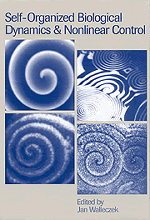 Self-Organized Biological Dynamics and Nonlinear Control
Self-Organized Biological Dynamics and Nonlinear Control Book contents
- Frontmatter
- Contents
- List of contributors
- Preface
- The frontiers and challenges of biodynamics research
- Part I Nonlinear dynamics in biology and response to stimuli
- Part II Nonlinear sensitivity of biological systems to electromagnetic stimuli
- Part III Stochastic noise-induced dynamics and transport in biological systems
- Part IV Nonlinear control of biological and other excitable systems
- 14 Controlling chaos in dynamical systems
- 15 Electromagnetic fields and biological tissues: from nonlinear response to chaos control
- 16 Epilepsy: multistability in a dynamic disease
- 17 Control and perturbation of wave propagation in excitable systems
- 18 Changing paradigms in biomedicine: implications for future research and clinical applications
- Index
17 - Control and perturbation of wave propagation in excitable systems
Published online by Cambridge University Press: 14 August 2009
- Frontmatter
- Contents
- List of contributors
- Preface
- The frontiers and challenges of biodynamics research
- Part I Nonlinear dynamics in biology and response to stimuli
- Part II Nonlinear sensitivity of biological systems to electromagnetic stimuli
- Part III Stochastic noise-induced dynamics and transport in biological systems
- Part IV Nonlinear control of biological and other excitable systems
- 14 Controlling chaos in dynamical systems
- 15 Electromagnetic fields and biological tissues: from nonlinear response to chaos control
- 16 Epilepsy: multistability in a dynamic disease
- 17 Control and perturbation of wave propagation in excitable systems
- 18 Changing paradigms in biomedicine: implications for future research and clinical applications
- Index
Summary
Introduction
A physicist who wants to get a rough estimate of the acoustics of a concert hall just claps his hands and listens to the echoes. With this simple experiment he can obtain valuable information from the acoustic answer of the hall (at least if his ears are well trained). In more technical terms, one perturbs an unknown system with a very short pulse that in the ideal case would be a delta-function describing a perturbation of infintesimal short duration. Regardless of its specific nature, external perturbations belong to the most important methods for analyzing unknown systems. In this context, the perturbation by a short pulse is only one example for enforcing a characteristic answer. Other approaches include periodic perturbations where systematic variations of amplitude and frequency open ample possibilities to interrogate the system.
Although external perturbations have long proven to be a valuable tool for science and engineering, many experiments on novel systems studied in young emerging fields of science are dedicated to pure observation as a starting point. Investigations on spatial pattern formation in chemical and biological systems are an excellent example for this characteristic development of a young branch of experimental science (Field and Burger, 1985). Most of the current research activities in this field were triggered by the early work of Zhabotinsky and Winfree, who reported the observation of chemical waves in a reaction system that today is known as the Belousov-Zhabotinsky (BZ) reaction (Zaikin and Zhabotinsky, 1970; Winfree, 1972).
- Type
- Chapter
- Information
- Self-Organized Biological Dynamics and Nonlinear ControlToward Understanding Complexity, Chaos and Emergent Function in Living Systems, pp. 387 - 408Publisher: Cambridge University PressPrint publication year: 2000
- 2
- Cited by


